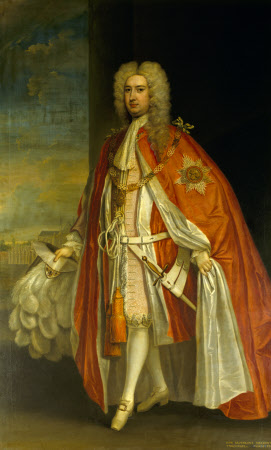Sir John Brownlow, 1st Viscount Tyrconnel (1690-1754)
Charles Jervas (Dublin 1675 – London 1739)
Category
Art / Oil paintings
Date
1730 - 1739
Materials
Oil on canvas
Measurements
2440 x 1420 mm
Place of origin
England
Order this imageCollection
Belton House, Lincolnshire
NT 436026
Caption
Sir John was the last of the Brownlows - save for his sister Anne, who married Sir Richard Cust, and brought Belton to the Custs. He is here seen here in his robes as a Knight of the Order of the Bath, which he became when George I revived the Order in 1725. The Chapel of Henry VII at Westminster Abbey, which was fitted up for the Order, can be seen in the background. He was the son of Sir William Brownlow (1665-1702) and Dorothy Mason (?1655?-1699/1700). He married firstly, Eleanor Brownlow (1691-1730); and secondly, Elizabeth Cartwright (d.1780). When between wives, he was turned down by the future Mrs Delany, despite all his assets, because “ …all that was no temptation to me, he had the character, very justly of being silly, and I would not tie myself to such a companion for an empire.”
Summary
Oil painting on canvas, Sir John Brownlow, 1st Viscount Tyrconnel (1690-1754) by Charles Jervas (Dublin 1675 – London 1739). Inscribed bottom right: JOHN BROWNLOWE VISCOUNT/TYRCONNEL. JERVAS FECT. A full-length portrait, turned slightly to the left, gazing at the spectator, in his robes as a Knight of the Order of the Bath, which he became when George I revived the Order in 1725, with the Chapel of Henry VII at Westminster Abbey, which was fitted up for the Order, in the background. Sir John Brownlow, Viscount Tyrconnel (1690-1754), 5th Bt and son of Sir William Brownlow (1665-1702) and Dorothy Mason (1655?-99/1700). He married, firstly, Eleanor Brownlow (1691-1730) and, secondly, Elizabeth Cartwright (d.1780). He was created Viscount Tyrconnel and Baron Charleville in 1718 and made Knight of the Order of the Bath in 1725. The gilt must have been taken off the gingerbread by his having to receive the Order of the Bath as an Irish peer, one day after the other recipients. In 1730 after Eleanor's death he wooed the indefatigable letter-writer Mrs Delany who felt that even though 'he had so vast a fortune, a title and was a very good natured man ...money without worth could not tempt her' 'He had the chracter, very justly of being silly, and I would not tie myself to such a companion for an empire'. Sir John was possessed of a driving ambition, but few political skills, and had an inordinately high opinion of his own importance, (an opinion not shared by his family, his colleagues or his peers). His pretensions and his faliure to achieve high office have tended to obscure a more positive side to his character - what one contemporary described as 'his nice taste and his well chosen knowledge' of the arts. It was this nice taste and well-chosen knowledge which were his greatest legacy to Belton. As an Irish peer he was still able to sit in the Commons and he continued to represent Grantham until his retirement in 1741. On the death of his wife's mother Alice Sherard, Lady Brownlow (1659-1721) Belton pased to him and became his main residence. He and his wife patronised the arts and he began to collect Old Masters and adapt Belton to their own taste. However he died without issue and his estates and half his possessions passed to his sister Anne Brownlow, Lady Cust (1694-1779) who instantly moved her family into Belton.
Provenance
Purchased with a grant from the National Heritage Memorial Fund (NHMF) from Edward John Peregrine Cust, 7th Baron Brownlow, C. St J. (b.1936) in 1984
Credit line
Belton House, The Brownlow Collection (acquired with the help of the National Heritage Memorial Fund by the National Trust in 1984)
Makers and roles
Charles Jervas (Dublin 1675 – London 1739), artist

